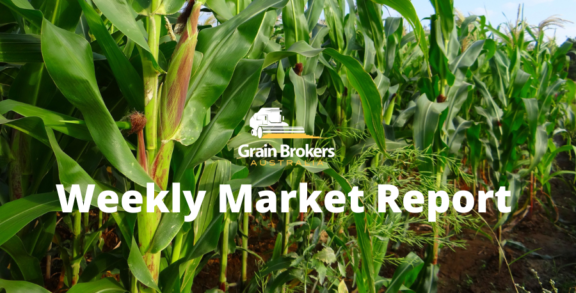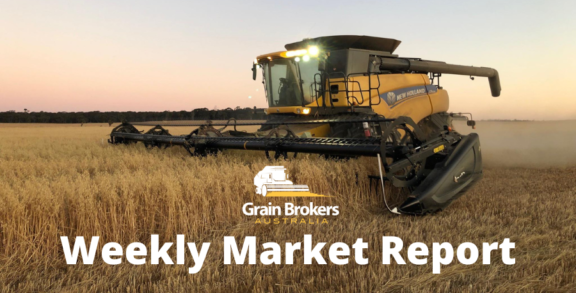
Sell the rumour, buy the fact …
By Peter McMeekin > Weekly Commentary
Global futures markets were sharply lower across the board last week and early this week, as the market digested the growing United States (US) corn and soybean yields, lagging US export sales and the Russians downplaying the persistent rumour of possible wheat export restrictions.
The annual Pro Farmer crop tour concluded on Friday and the results certainly confirmed that the US is in for a bumper summer crop harvest. After examining more than 2,800 corn and soybean samples, analysts pegged the US corn yield at 177.3 bushels per acre (bu/ac), producing 14.501 billion bushels (368MMT). This is slightly lower than the most recent United States Department of Agriculture (USDA) estimate of 178.4bu/ac.
The soybean picture was even brighter with pod counts more than 10 per cent above last year, resulting in a yield estimate of 53bu/ac. This is 1.4bu/ac above the USDA’s August forecast, producing a total of 4.683 billion bushels (127.5MMT). Chinese export demand is the key here and “Don’s Party” (US trade tariff war) is not helping. China is currently stocking up on Brazilian beans and is also expected to decrease imports by 6MMT to 93MMT, thereby decreasing their requirement for the US product.
Wheat suffered the most, with falls across all the major European and US bourses. The funds had built significant longs over the past few months and profit taking saw them liquidate more than 35 per cent of this position. As a result, the market has given most of the past month’s gains.
Nevertheless, this was certainly not driven by market fundamentals. The global wheat balance sheet remains tight. Late last week the International Grains Council (IGC) lowered their global production forecast by 5 million metric tonnes (MMT) to 716MMT. They took 3MMT off the Australian crop, but still have it above 20MMT.
One of the key numbers to come out of the IGC report was a substantial decrease in the ending wheat stocks held by the major exporters. They are projected to fall to 62MMT by the end of the 2018/19 season, down from 81MMT at the end of the previous season. The major contributors to this decline were Russia, down 33 per cent to 10MMT, the EU, down 31% to 13.7MMT and the US, down 18 per cent to 24.7MMT.
As we have seen in recent years, Russia holds the key to global wheat values. Despite their protestations, the trade believes there is still a distinct possibility of Russian wheat export restrictions later in the season. Exports above 30MMT appear to be the potential trigger.
The IGC has penciled Russia in for 30.4MMT of exports in the 2018/19 marketing year. This is 4.6MMT below the USDA forecast. They are currently exporting around 1MMT of wheat per week. At that pace, exports would hit 30MMT in February. However, it would be optimistic to think that pace could be maintained through the approaching winter months.
Here in Australia, ASX wheat futures fell $14 last Friday, to close at $395. New crop APW bids were easy across all port zones. The export states of South Australia (SA) and Western Australia (WA) saw the most dramatic decline with Port Adelaide, Port Lincoln and Kwinana values all down around $20. Feed barley prices fell at least $25 in the same port zones.
The fall in international values undoubtedly had an influence, but so did the forecast of rains throughout the key demand regions of northern New South Wales and southern Queensland. Generally disappointing would be the best way to describe the outcome. As happens so often during prolonged dry spells, the weather forecast promised more than was eventually delivered.
Not even a change of Prime Minister could open the heavens and provide some drought relief. Scott Morrison will see, and experience, the desperation first hand this week when he visits parts of western Queensland that have been drought declared for more than five years.
The focus for the northern New South Wales and southern Queensland grain grower has now switched to summer crop. The sorghum planting window is fast approaching and soil moisture is desperately required. Most growers would require at least 100mm to get the ball rolling. The soil temperature is still too low but once it reaches 14 degrees and rising then the game begins, as long as the rain arrives.
Whilst sorghum cannot replace all of the white grain demand, it can certainly replace some. With adequate rain, the potential sorghum plant is huge, and the pressure then comes off feed grain values. Without it, prices remain supported and the east coast domestic consumer will continue to rely on imports of wheat and barley from Victoria, SA and WA until the 2019 winter crop harvest replenishes stocks.
In the mining industry, there is a saying: buy the rumour sell the fact. When it comes to the current Australian grain market environment, it is more like sell the rumour (forecast of rain), buy the fact (disappointing rainfall outcomes).






